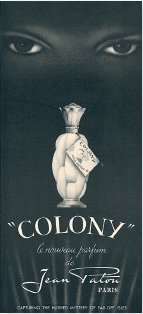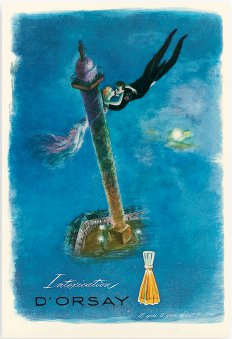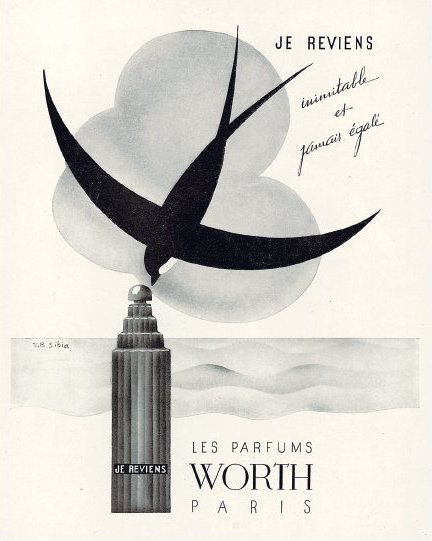Scent and Subversion (10 page)
Read Scent and Subversion Online
Authors: Barbara Herman

Strawberry, peach, and orange blossom sweeten Sortilège without rendering it teenagerish or immature. Aldehydes are strong in the opening, as orris’s woody powder adds fairy dust to the voluptuous base of balsams, woods, and animal notes. I’ve noticed that sandalwood in vintage scents seems more intoxicating, buttery, rich, and powdery than in contemporary scents. Perhaps I’m smelling the difference between real and synthetic sandalwood.
Boozy, lush, animalic, but ladylike, this is one of those perfumes that, to the untrained nose, might be described as “smelling like my grandma.” Well, maybe if your grandma was Colette or Marlene Dietrich …
Top notes:
Aldehyde complex, bergamot, peach, strawberry, orange blossom
Heart notes:
Rose, jasmine, lily of the valley, ylang-ylang, orris, lilac
Base notes:
Vetiver, sandalwood, vanilla, tonka, opopanax, civet, musk
by Fabergé (1938)
Aphrodisia (“for the night-blooming you”) is a luscious and complex floral chypre bursting with fruity sweetness and tempered with spice, mossiness, and animalic warmth.
A great example of an animalic perfume that isn’t dark and brooding, Aphrodisia radiates joy and warmth, and has the olfactory color palette and texture of those rich-hued Art Deco works by Tamara de Lempicka. If this is the drugstore version of a
once-grander Aphrodisia, perfume lovers back in the day still had it better than we do. (Or at least, better than women on a budget today.) Perfumer Yann Vasnier described Aphrodisia as spicy (due to its clove note), soapy, and with a “vaguely Mitsouko back.”
Top notes:
Bergamot, lemon, neroli, fruit note
Heart notes:
Rose, honey, ylang-ylang, carnation, jasmine
Base notes:
Oakmoss, vetiver, civet, ambrein, musk
by Jean Patou (1938)

In this 1938 ad for Jean Patou’s Colony perfume, it’s unclear if the eyes peering mysteriously over the pineapple-shaped bottle belong to the colonized or to the white colonizer. Either way, racialized darkness is at the heart of its colonial fantasy.
Combining pineapple with a leather-chypre base, the wonderfully weird Colony was, at Paris’s Exposition Coloniale in 1931, an argument in perfume form for France’s colonial exploits. Colony hits my nose with rubber, chypre mossiness/woods, and a tart-turned-golden-sweet pineapple note, finally drying down to rich amber and benzoin. (Not incidentally, pineapple and rubber are two exports from countries that were colonized by France.) Although there’s not an easy relationship between the pineapple and the leather/moss notes, Colony somehow works.
The Baccarat-designed bottle, which is the design version of a Freudian slip, looks like both a pineapple and a hand grenade, as filmmaker and perfume writer Brian Pera has noted. This visual pun celebrates France’s spoils from the tropics while (unconsciously) intimating that they were gained through violence. Insofar as one can psychoanalyze a perfume bottle (and why not?), the hand grenade / pineapple could be said to embody Colony’s ambivalence as a champion of colonialism.
Top notes:
Pineapple, ylang-ylang
Heart notes:
Carnation, iris, vetiver, opopanax
Base notes:
Leather, musk, oakmoss
by D’Orsay (1938)

A pair of lovers straight out of a Marc Chagall painting kiss one another as they float above a city in this intoxicating ad from 1946.
As unabashedly vintage as a cigarette holder in the hands of a woman with a 1930s-style moon manicure, Intoxication by D’Orsay lives up to its name. Its sharp florals are sexy and bright rather than dark and dangerous, like Narcisse Noir, or verging on cloying like Fracas.
A spicy floral with an animalic undertow, Intoxication is similar in personality to Revlon’s Intimate: There’s something playful and fun about its sexiness—something American, maybe, rather than French.
Top notes:
Bergamot, lemon, mandarin
Heart notes:
Rose, orange blossom, jasmine, lily of the valley, nutmeg, ylang-ylang
Base notes:
Vetiver, patchouli, vanilla, sandalwood, tonka, musk, benzoin
by Blanchard (1938)
For everything in our pornified world that is shown visually, a dimension seems to be subtracted from perfume. Repression, in other words, must have been really good for scent. Jealousy, a floral chypre, starts off as an innocent corsage of intensely sweet notes (honey, lilac, and hyacinth?). Those “innocent” notes are darkened with spice and musk, and then Jealousy dries down to a soft, powdery, and civety base.
Notes not available.
by Bourjois (1938)
Mais Oui is a happy, bright little thing, calling out its friendliness and openness to life (“Mais, Oui!”) in its notes as well as its name. This beautiful floral aldehydic scent has a Femme-like warmth (peach or plum?) with a lovely animalic base that reads as leather. According to perfume historian Octavian Coifan, Mais Oui is overdosed with Animalis, a Synarome base with civet, musk, castoreum, leather, and costus. Rrreow!
Notes from
Yann Vasnier:
An animalic fougère with a cresolic or “coal-tar” note, clover, salicylates, coumarin, civet

One of perfume copy’s enduring tropes is that perfume allows the proper woman to subliminally express an otherwise scandalous sexuality. This takes a punningly linguistic turn in the name for Bourjois’s Mais Oui. In English, it sounds like a question, even a proposition: “May we?” And in French, the provocative answer: “But yes!”

In this 1950 ad by artist T.B. Sibia, the Lalique-designed columnar bottle of Je Reviens looms on the horizon like a tall building.
by Fabergé (1938)
Violet sings from the heart of Straw Hat, its sweetness rounded by vanilla and woody, hay-like notes. A poetic rendition of summer with violet suggesting a tinge of sentimentality or reminiscence.
Top notes:
Lemon, lavender, and geranium
Heart notes:
Rose, violet, heliotrope, patchouli
Base notes:
Vanilla, musk, sandalwood
by Fabergé (1938)
Like a riff on Dana’s iconic Tabu, Tigress starts off with a sharp blast of bergamot and a strong amber component underneath the florals. It has a momentary soapiness/powderiness that makes it a lot more ladylike than you would think a perfume called “Tigress” would be.
That soapy/powdery lady is quickly thawed out by a spicy note that gets this fragrance cooking again. Although you can smell the vanilla in the drydown, Tigress isn’t cloying or overpowering. In fact, one of the things I like best about it is how it develops into something fairly dry and mossy, with incensey and even chalky facets. As it dries down, something animalic (a civet note?) lurches forward, only to retreat back into the shadows. Tigress should be a cacophonous mess, but it’s lovely.
Notes from
Yann Vasnier:
A powdery woody Oriental with moss and vanilla
by Caron (1939)
Perfumer:
Ernest Daltroff
If you’ve ever hiked near the mountains, you know what it’s like to feel as if you’re in multiple climates at once. You can be cold in the valleys in the morning, smelling fresh herbs, aromatic pine, and juniper trees that cool the air with their pungent camphorous scent. Then suddenly, the sun roars overhead, scorching you as you look, blinkingly, at snow on the side of the mountain as your skin begins to burn. Then, just as suddenly, in front of you lies a meadow full of fragrant flowers and maybe a bush or two of ripe fruit.
Introduced in 1939 for the World’s Fair in New York, Alpona—Daltroff’s olfactory tribute to the Swiss Alps—is considered the first fragrance to combine florals with grapefruit. If you’re thinking of it in terms of the bright and watery citrus fragrances of today, think again. Ernest Daltroff’s perfumes always have an edge.
There is also depth in the chypre base, with incense and resins. As Gaia Fishler said about Alpona on her blog, The Non-Blonde: “This is full of what the bureaucrats consider skin allergens and perfume lovers see and smell as beauty.” Amen.
If Chanel No. 19 is a fairy-tale witch lurking in dark woods, providing cool whiffs from the luxuriant undergrowth, Alpona is Julie Andrews singing atop a mountain in
The Sound of Music,
swirling, larger than life, and joyous. When you get to the base, a stark and smoky incense smolders, ever so slightly laced with its earlier orange note.
Panoramic in its scope and development, Alpona is like a perfume that has discovered 3-D and Technicolor, and sets out to show off what it can reveal to you, in mind-blowing detail. This perfume’s depth and development make many other perfumes feel like shallow lifetime biopics, with crappy music, one-note actors, and cheap sets and wardrobes.
Top notes:
Lemon, grapefruit, bergamot, orange
Heart notes:
Rose, jasmine, orchid, thyme
Base notes:
Patchouli, myrrh, cedar, sandalwood, musk, and oakmoss
(Notes from NowSmellThis.com.)
by Lenthéric (1939)
A rich amber Oriental in the vein of Weil’s Secret of Venus and Zibeline, Confetti’s balsamic base probably included vanilla, tonka, tolu, labdanum, and other resins that contribute to its rich feel. Whoever is wearing the dark and sensuous Confetti is not in the middle of the room getting hit by sprays of confetti, but in a hidden corner of the party, making out. Its drydown suggests that the musk and civet are prowling around and whispering sweet nothings in the background.
Notes not available.